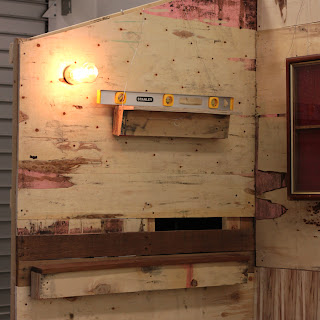Flatpack Sculptures (series 2)
Object 1.
Object 2.
- Simple shapes made of squares and rectangles. The colours come from a limited palette. I like creating objects that are restricted to two or three colours. The materials used have both smooth and rough surfaces. Because the objects are quite small the space plays an important role, at this size I hope they become intriguing. Everything else seems to dwarf the little fellas. They are humble pieces that shy away from making any bold or awkward statements. Whimsical perhaps but never trivial. They seek to engage the viewer.
- The objects are formal. The subject matter is about the insignificant, common material, the colours, the form and structures. They are intimate pieces.
- The materials are mostly discarded materials. I like the idea of jetsam floating on the streets and I’m rescuing it to give it a new life. From the odd buttons I find, to the cardboard I tear from boxes that are pulled from bins. I like tying objects together using thread and eyelets. It seems the tidy thing to do. And it is respectful to the injured materials I have rescued.
- They are presented on miniature plinthes made from the offcuts of pallets I have dissected for another project. They are close to other 2D artworks that reflect the same minimal form and colours. They sit upon my desk, which is slowly being consumed by an installation made of webs. The actual presentation for these objects will take place in several weeks, where they will find themselves on the street.
- The artwork is abstract, minimal and once set free will be ephemeral street art. It may also contain traces of constructivism (Whilst being an extremely complex movement which the exact meaning was debated vigorously within art institutions, has origins based on angular shapes and simple colour schemes), suprematism (Geometric shapes in limited colour scheme), de stijl or neoplasticism (which only allows non-colours and shapes such as squares and rectangles).
- To access this work, you may need some understanding of art using found objects or assemblage. Street art. Modern art, minimalism. Architecture in the 20th century. The use of cardboard and the recycling of materials.
- Design and architecture from the modern era. Recycling of materials has had a big influence on me. The idea but also the need as I am too poor to afford materials.
- I grew up in a home with a low income. Although I was not made aware of this until I was older. I guess mumma and pappa did a good job of hiding this from me. We did a little recycling and the lack of toys at my disposal brought about the urge to create things to play with. I recall wandering the streets of Kingscliff searching for paddle pop sticks or junk that I could use to make cool things with.
- Recycling, reclaiming and reusing is something that we've been doing for centuries. From the recycling of Bronze in Roman times 400BC to recycling during economic slumps such as after WWII. But this is more of a global thing than simply something that happens in the Western world. People have been reclaiming wood and materials to fashion new items in villages in Africa and India for years.
- Artists who create this kind of art include. Richard Tuttle. Eugene Carchesio. Gareth Donnelly. Madonna Staunton.
- Technology will play a vital role in my work. Having made the decision to display these works on the street under an anonymous body of artists. I am able to document with a camera and blog about later.
- The first series of flatpack sculptures were displayed over at the conservatorium of music on a small rotunda. The reason I feel it is important to bring artwork of this kind to the street is for the people that do not subscribe to the cult of galleries. I was considering the type of folk that would invest in my artwork at a gallery and the very few that would come to enjoy it. I believe by placing such a work on the street, not only am I exposing my art to a different audience but I am enlightening people to the joys of a different, less obtrusive kind of street art.
Red and Blue Chair by Gerrit Reitveld (De Stijl)
Richard Tuttle. Light and Colour 2007.
Eugene Carchesio. Silence is Golden. 1994-95






















